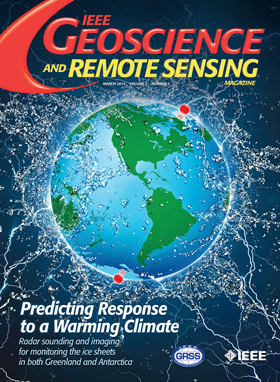泛锐化中的机器学习:从浅层到深层网络的基准
IF 16.2
1区 地球科学
Q1 GEOCHEMISTRY & GEOPHYSICS
引用次数: 46
摘要
机器学习(ML)通常通过最先进的方法影响着几个研究领域的文献。在过去的几年里,ML已经被探索用于泛锐化,即一种基于多光谱(MS)图像和更高空间分辨率全色(PAN)数据组合的图像融合技术,其特征在于其中/低空间分辨率。因此,泛锐化的ML代表了一条值得进一步研究的新兴研究路线。在本文中,我们介绍了最近在相关文献中提出的一些强大且广泛使用的基于ML的泛锐化方法。对八种方法进行了广泛的比较。这八种方法的实现,利用通用软件平台和ML库,是为了进行比较而开发的。pansharpening的ML框架将免费分发给科学界。显示了使用五个常用传感器获取的数据进行泛锐化的实验结果,以及用于性能评估的成熟协议(在降低分辨率和全分辨率下)。将基于ML的方法与由经典和基于变分优化(VO)的方法组成的基准进行了比较。基于实例训练哲学,报告了每种泛锐化技术的优缺点,并进行了广泛的计算分析。工具箱在中提供https://github.com/liangjiandeng/DLPan-Toolbox.本文章由计算机程序翻译,如有差异,请以英文原文为准。
Machine Learning in Pansharpening: A benchmark, from shallow to deep networks
Machine learning (ML) is influencing the literature in several research fields, often through state-of-the-art approaches. In the past several years, ML has been explored for pansharpening, i.e., an image fusion technique based on the combination of a multispectral (MS) image, which is characterized by its medium/low spatial resolution, and higher-spatial-resolution panchromatic (PAN) data. Thus, ML for pansharpening represents an emerging research line that deserves further investigation. In this article, we go through some powerful and widely used ML-based approaches for pansharpening that have been recently proposed in the related literature. Eight approaches are extensively compared. Implementations of these eight methods, exploiting a common software platform and ML library, are developed for comparison purposes. The ML framework for pansharpening will be freely distributed to the scientific community. Experimental results using data acquired by five commonly used sensors for pansharpening and well-established protocols for performance assessment (both at reduced resolution and at full resolution) are shown. The ML-based approaches are compared with a benchmark consisting of classical and variational optimization (VO)-based methods. The pros and cons of each pansharpening technique, based on the training-by-examples philosophy, are reported together with a broad computational analysis. The toolbox is provided in https://github.com/liangjiandeng/DLPan-Toolbox.
求助全文
通过发布文献求助,成功后即可免费获取论文全文。
去求助
来源期刊

IEEE Geoscience and Remote Sensing Magazine
Computer Science-General Computer Science
CiteScore
20.50
自引率
2.70%
发文量
58
期刊介绍:
The IEEE Geoscience and Remote Sensing Magazine (GRSM) serves as an informative platform, keeping readers abreast of activities within the IEEE GRS Society, its technical committees, and chapters. In addition to updating readers on society-related news, GRSM plays a crucial role in educating and informing its audience through various channels. These include:Technical Papers,International Remote Sensing Activities,Contributions on Education Activities,Industrial and University Profiles,Conference News,Book Reviews,Calendar of Important Events.
 求助内容:
求助内容: 应助结果提醒方式:
应助结果提醒方式:


